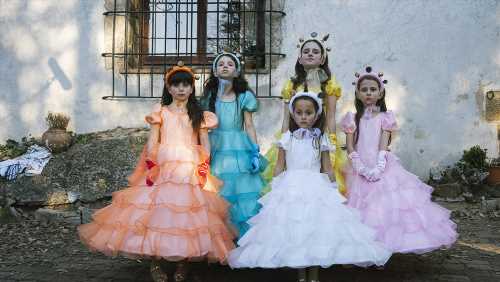In 2017, Movistar Plus, Spain’s biggest SVOD-pay TV player, rocked the San Sebastian Festival, the highest-profile movie event in Spain and Latin America region, with “The Plague,” the biggest series ever made in Spain.
Movistar Plus, owned by Telefónica, looks set to make waves again at this week’s San Sebastian by world premiering another big, bold series: “La Mesías.”
It’s written, directed and produced by Javier Ambrossi and Javier Calvo – known in Spain as Los Javis – marking their follow-up to overseas breakout “Veneno,” a raunchy but highly grounded bio of Spanish trans icon Cristina Ortiz. “Veneno” was picked up by HBO Max for the U.S. market and made Ambrossi and Calvo among the most courted young showrunners in Europe.
“We’ve had to say ‘no’ to a lot of things, to big offers, a lot of money from and outside Spain, to keep faithful to ourselves, and battle to remember we wanted to make ‘La Mesias’ how we have,” Ambrossi recalls.
The very existence of Movistar Plus is itself an innovation. In continental Europe, no other telecom has driven so determinedly into original production, releasing on average 11 new series or returning seasons every year since September 2017.
“Many other telecoms in Europe – Deutsche Telekom, Vodafone – don’t produce so much content directly. They prefer to be third-party aggregators,” says María Rua Aguete, senior research director, media & entertainment, Omdia.
“This is the unique differentiator and reflects Movistar Plus’ origins in its 2015 purchase of Canal Plus, whose management team had a tradition of content production.”
In a first phase of overseas expansion, spanning 2015-18, Netflix and indeed Movistar Plus launched ambitious series such as “Money Heist” and “Dark” (both Netflix) and “The Plague.”
These days, however, facing a global streamer investment downturn and weak economic environment, “Buyers are playing it safe at the moment and the safe option is crime in uncertain times,” Keshet Intl.’s Anke Stoll said at June’s Conecta Fiction TV forum in Spain.
Movistar Plus, in contrast, has stayed the course, giving full rein to its auteurs, releasing, for instance, 2020’s “Riot Police,” a compassionate take on members of a special intervention unit from “The Beasts” director Rodrigo Sorogoyen, and now “La Mesías.”
“Movistar understood from the first that this was a big auteur series. There aren’t that many [series] that enjoy that creative freedom and are yet mainstream. ‘La Mesías’ has both those elements,” says Ambrossi.
A family-framed psychological mystery thriller, “La Mesías” begins with thirtysomething Enric who literally wets himself watching a viral video of Stella Maris, a Christian pop band led by his sisters.
Memories flood back of his own childhood and youth, scarred by his parents’ religious fanaticism, climaxing in mother Montse channelling her narcissism into declaring herself the daughter of God.
Enric escaped. Yet “you can’t escape trauma, it’s part of you, but you can evolve,” says Calvo. Though deeply traumatized, Enric sets out to save his sisters, still locked up in the family home.
Ambrossi and Calvo have “a level of artistic ambition, authenticity, their own voice, a total ability to render accessible the toughest of issues; nobody manages emotion better,” says Domingo Corral, Movistar Plus director of fiction and entertainment. “That combination means that in watching ‘La Mesías,’ you sense you’re seeing an original, unique, different series.”

The series’ intense seven episodes weigh in mostly just over an hour each. The story’s timeline hops from 2013 to the 1980s, when Enric and younger sister Irene are kids, to around 1997, catching them in their late teens. The production shot totally on location, mostly at 30 rural sites outside Barcelona. The series featured 170 characters and 3,800 extras.
Most vital, says Corral, was the shoot’s length: 25 1/2 weeks, split in two blocks in Spain, separated by an interval, and one week in India.
“You do things better if you’re not under pressure, and they shot with children, who bring a huge sense of truth to the series but require time,” Corral says.
José Luis Rebordinos, San Sebastian Festival director, says, “When I watch ‘La Mesías’ in a movie theater, I’m watching a film; when I watch the film on a television or on a device, I think that they are not the right places to watch it ‘La Mesías’ is cinema in its purest state.” The scenes set in the past were shot in 16mm, capturing the impressionism of memory; digital camera work for 2013 brings a painful present into sharp relief.
“This is a highly artistic, auteurist series, but a big production made at the highest level of production standards,” says Maria Valenzuela, general manager at Movistar Plus+ International.
Most notably, perhaps, Ambrossi and Calvo bring their hallmark visceral sense of diversity to each and every scene and episode, which lends them their large distinction.
“We’re not very conscious of it, but you can see diversity in how each character reacts differently to trauma, as well as the genre mix and diversity of settings. It’s a bit like how we are; we like a lot of things and modes,” says Calvo.
Episode 1 blends psycho-drama and sci-fi, for example, while Episode 2 has procedural elements; Episode 3 works like a real-life musical. The series’ highly worked soundtrack runs the gamut from classical music to pop hits like “Bette Davis Eyes” to Rocío Durcal’s apocalypse-set love song “Cuando llegue el fin del mundo” to the sisters’ Christian pop rap, created by Spanish underground duo Carlos Ballesteros and Genís Segarra. Rosalía producer Raül Refree composed the series’ original soundtrack.
“Being commercial doesn’t have to mean pre-fabricating something for immediate consumption. If you can make something with a certain weight, which is cinematographic, original, with a certain depth, you can touch people, and I think ‘La Mesías’ will,” says Calvo.
San Sebastián will deliver a first idea of whether Los Javis have succeeded. Going into the Festival, buzz on the series was highly positive.
Read More About:
Source: Read Full Article
